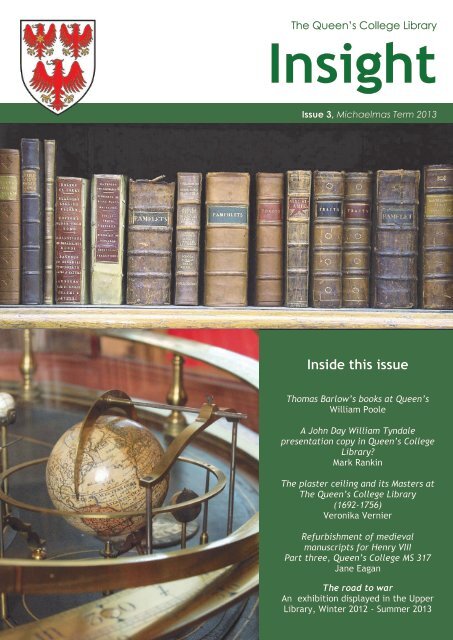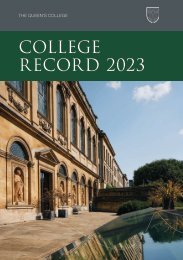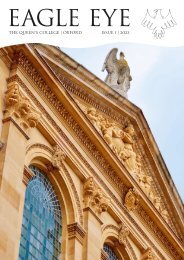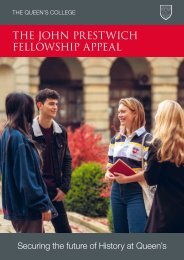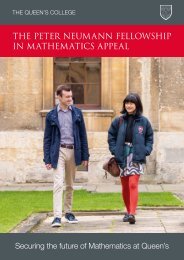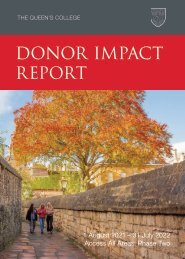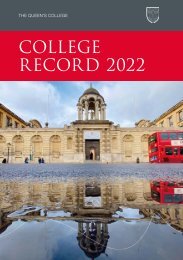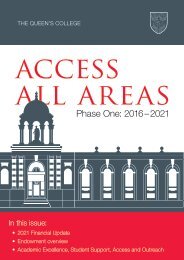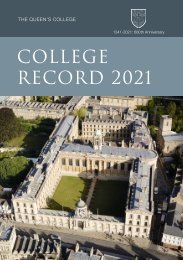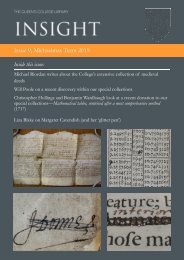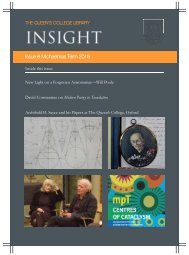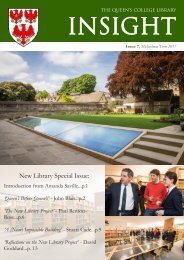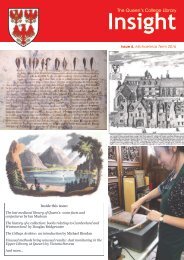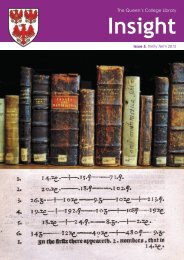Create successful ePaper yourself
Turn your PDF publications into a flip-book with our unique Google optimized e-Paper software.
The Queen’s College Library<br />
<strong>Insight</strong><br />
Issue 3, Michaelmas Term <strong>2013</strong><br />
Inside this issue<br />
Thomas Barlow’s books at Queen’s<br />
William Poole<br />
A John Day William Tyndale<br />
presentation copy in Queen’s College<br />
Library?<br />
Mark Rankin<br />
The plaster ceiling and its Masters at<br />
The Queen’s College Library<br />
(1692-1756)<br />
Veronika Vernier<br />
Refurbishment of medieval<br />
manuscripts for Henry VIII<br />
Part three, Queen’s College MS 317<br />
Jane Eagan<br />
The road to war<br />
An exhibition displayed in the Upper<br />
Library, Winter 2012 - Summer <strong>2013</strong>
2<br />
THE QUEEN'S COLLEGE LIBRARY NEWSLETTER<br />
working to a very tight timescale in order to allow<br />
us to re-open the Lower Library to students at the<br />
beginning of the Michaelmas Term, when the<br />
removal process will be reversed. While the<br />
wholesale emptying of the Lower Library was<br />
taking place on the ground floor, upstairs a second<br />
team of fine art specialists from Crown were<br />
carefully wrapping and packing our manuscript<br />
collection and the globes, orrery and statue of<br />
Queen Philippa. These are now all in storage for<br />
six months until the work in the Upper Library is<br />
completed at the beginning of next year. Images<br />
of some parts of the move are displayed here.<br />
Above: The statue of Queen Philippa and one of the globes<br />
from the Upper Library packed into custom crates and ready<br />
to go into storage until January 2014.<br />
W<br />
elcome to Issue Three of <strong>Insight</strong>. I<br />
am writing this introduction in<br />
somewhat different circumstances<br />
than the previous two years, as I<br />
am sitting in a room in Back Quad which has<br />
become the temporary library office for the Long<br />
Vacation whilst a full scale refurbishment project<br />
takes place in the historic library building.<br />
The refurbishment of the Upper and Lower<br />
Libraries had always been planned to be the last<br />
part of our long term plans to extend the library<br />
building under the Provost’s Garden, but as the<br />
date for the full project remains uncertain it was<br />
agreed to go ahead with the refurbishment<br />
separately. This was a timely decision because the<br />
heating and lighting systems in the historic library<br />
are long overdue for replacement, and concern has<br />
been felt in the College for some years that the<br />
systems might fail altogether. The floorboards<br />
have to come up in both the Upper and Lower<br />
Libraries to replace the heating and wiring, so it<br />
was decided to take the opportunity to undertake a<br />
full scale renovation of both parts of the building<br />
in the shortest possible timescale in order to<br />
minimise disruption to library users. It is intended<br />
that next year’s <strong>Insight</strong> will be a “buildings<br />
special” as I have asked the members of the<br />
project team, including the specialist conservators<br />
working on the stonework, plaster and timber, to<br />
contribute to what I expect to be a bumper issue.<br />
Immediately after the end of Trinity Term a team<br />
of removal specialists from Crown Fine Arts<br />
undertook the packing and removal to storage of<br />
all the books from the Lower Library, some 35,000<br />
volumes, a feat which was achieved in less than a<br />
week. The contractors started the following week,<br />
In the meantime, to whet the appetite for next<br />
year’s “building special” I am pleased to include in<br />
this year’s issue an article by my former colleague<br />
Veronika Vernier on the plaster ceiling in the<br />
Upper Library. Other articles include a paper by<br />
Will Poole from New College on the Library of<br />
Thomas Barlow, whose donation of a large<br />
collection of books to the College in the late<br />
seventeenth century was one of the main drivers<br />
for the construction of the Upper Library in the<br />
1690’s. Mark Rankin from James Madison<br />
University has written about the Queen’s copy of<br />
Tyndale’s Whole Works which has an interesting<br />
provenance and has added to his research project<br />
on perceptions of Henry VIII after the enactment<br />
of the Royal Supremacy in 1535. Last but not least<br />
Jane Eagan of the Oxford Conservation Consortium<br />
has written the third in her series on the<br />
conservation of our Henrician manuscripts.<br />
As always I am most grateful to all the contributors<br />
and in particular to Lynette Dobson who has<br />
produced the Newsletter for us and taken many of<br />
the photographs.<br />
If you have ideas for future articles or indeed<br />
would like to contribute, please contact me at<br />
amanda.saville@queens.ox.ac.uk<br />
Amanda Saville<br />
Librarian<br />
July <strong>2013</strong><br />
Cover images: A shelf of bound antiquarian<br />
pamphlets and tracts in our Select Store; the<br />
miniature globe inside the Upper Library orrery.
Thomas Barlow’s books at Queen’s 3<br />
Thomas Barlow’s books at Queen’s<br />
William Poole<br />
New College, Oxford<br />
Fig. 1: Portrait of Thomas<br />
Barlow from the College’s<br />
collection.<br />
T<br />
homas Barlow<br />
(1607-91) (fig. 1)<br />
was one of the<br />
more interesting<br />
of seventeenth-century<br />
Oxford’s ‘public intellectuals’.<br />
He started out as<br />
an undergraduate at<br />
Queen’s in the 1620s, and<br />
rose successively as<br />
Bodley’s Librarian (1652-<br />
60), Provost of Queen’s<br />
College (1658), Lady<br />
Margaret Professor of<br />
Divinity (1660), Archdeacon<br />
of Oxford (1664), and finally Bishop of Lincoln<br />
(1675). As Provost of Queen’s, he succeeded<br />
another great scholar, Gerard Langbaine, who had<br />
married his predecessor’s widow and eventually<br />
died ‘of an extream cold’ caught from overwork in<br />
the Bodleian. Langbaine had cultivated at Queen’s<br />
in the interregnum a tactfully royalist culture<br />
which attracted many future loyalist statesmen<br />
and intellectuals. Queen’s during Barlow’s tenure<br />
as Bodley’s Librarian was home to such future<br />
luminaries as Sir Joseph Williamson, who was to<br />
serve as secretary for state and second President of<br />
the Royal Society of London. His almost exact<br />
contemporary Sir Robert Southwell had also been<br />
a student at Queen’s in the 1650s, where he turned<br />
his hand to poetry; some quirky verse survives on,<br />
for instance, musical meetings in interregnum<br />
Oxford, as well as the death of a New College<br />
choirboy who fell out of a mulberry tree and<br />
brained himself. 1 Southwell later became a<br />
prominent diplomat and, like Williamson, President<br />
of the Royal Society of London. A less worldly<br />
contemporary was the stupor mundi Thomas<br />
Hyde, a man who, like Barlow, would become<br />
Bodley’s Librarian too, as well as holding chairs in<br />
both Arabic and Hebrew. Hyde specialised in<br />
Persian and Turkish, and even dabbled in Chinese,<br />
the first English scholar to do so in any depth.<br />
Queen’s over these decades was indeed a bookish<br />
Fig. 2: “The devil’s handwriting”, from Teseo Ambrogio’s<br />
1539 publication, Introductio in Chaldaicam lingua[m],<br />
Syriaca[m] atq[ue] Armenica[m], & dece[m] alias linguas.<br />
Sel.c.29.<br />
place. At the time when Barlow was an undergraduate,<br />
the College opened an undergraduate library<br />
distinct from that of the fellows, the ‘Taberdars<br />
Library’, to which Barlow would later donate at<br />
least one book 2 . From these earlier decades too<br />
survives the lively diary of Thomas Crossfield of<br />
Queen’s, to whom we owe much of our knowledge<br />
of the social life of the College at that time. When<br />
Langbaine died, he bequeathed a portion of his<br />
books to the Bodleian and another to Queen’s, a<br />
custom Barlow too would follow. After the Restoration<br />
the College Library became a well-known<br />
spot for academic tourism, largely because of the<br />
alleged sample of the devil’s handwriting there: ‘…<br />
that dung fork, pothook hand / That in Queen’s<br />
Colledge Library does stand.’ 3 (fig. 2)<br />
Barlow, who had presided over the Bodleian’s<br />
reception of Langbaine’s friend John Selden’s<br />
library in the late 1650s, made plans to bequeath<br />
his own collection long before his death. He first<br />
announced his intentions on 2 June 1675 after a<br />
good dinner in Queen’s. Barlow declared that he<br />
intended to leave all his books to the Bodleian<br />
Library, such as they had not already, and the<br />
residue to Queen’s. He had wavered over which<br />
institution to prefer, but in the end resolved upon<br />
the Bodleian as his chief beneficiary, saying that<br />
‘he had allready six hundred volumes at least<br />
which the University library had not.’ A week after<br />
this dinner, the fastidious Savilian professor of<br />
Geometry John Wallis, who had been present,<br />
wrote down a testimonial as evidence of Barlow’s<br />
intentions, presumably lest the bishop-elect<br />
renege on his promise. 4<br />
The portion of Barlow’s library unwanted by the<br />
Bodleian eventually arrived in Queen’s in the mid-<br />
1690s. The Bodleian accounts show that almost<br />
£40 was paid over two years to Queen’s for<br />
‘Carriage of the Bishop of Lincolne’s Bookes giuen
4<br />
THE QUEEN'S COLLEGE LIBRARY NEWSLETTER<br />
there are not more Barlow books in Queen’s, as<br />
one would have thought that Barlow’s duplicates<br />
as identified against the Bodleian stock in the<br />
1690s must have exceeded his singletons. So in<br />
theory there should be thousands of Barlow books<br />
in Queen’s to match the thousands in the Bodleian;<br />
following the Barlow bequest, the entry in the<br />
College’s Benefactors Book (fig. 3), we might note,<br />
spoke of ‘the old library not being capacious<br />
enough for so many books, a burning desire arose<br />
to build a new library’ – as of course transpired.<br />
Despite the comparative neglect of the Queen’s<br />
Barlow books by scholars, they are accessible<br />
because the Queen’s librarians have done more to<br />
identify and describe their Barlow books than their<br />
Bodleian counterparts. And for the reasons stated<br />
above they are attractive often precisely because<br />
the Bodleian already held an (unmarked) copy,<br />
and Barlow’s (marked) copy thus went to his own<br />
college. Thinking just of ex dono authoris or<br />
editoris copies, work with inscriptions in the<br />
Queen’s books shows up patterns of donation and<br />
friendship that are not visible in the Bodleian:<br />
presentation copies from the orientalist Thomas<br />
Hyde, for instance (fig. 4); 6 and, over a period of a<br />
Fig. 3: Thomas Barlow’s entry in the Queen’s Benefactors Book<br />
to the Library’, which suggests that Queen’s<br />
organised carriage from Buckden, where Barlow’s<br />
episcopal residence was, and that the Bodleian<br />
agreed to reimburse the College, and send on<br />
duplicates. 5<br />
We do not really know how many books came to<br />
Queen’s from the Bodleian, or indeed how large<br />
the initial shipment was, not least because both<br />
libraries duplicate-stripped their stock at many<br />
points over the subsequent centuries. Today,<br />
Queen’s librarians have spotted about half a<br />
thousand genuine Barlow books in the library.<br />
Given that the Bodleian was very likely already to<br />
hold copies of popular or topical books, as well as<br />
by law most seventeenth-century London imprints,<br />
we might predict that the Bodleian was<br />
more likely to receive out-of-the-way Barlow<br />
books, having no need for Barlow’s more common<br />
titles. Certainly, the corollary holds: the Barlow<br />
books at Queen’s are dominated by recent Oxford<br />
and London imprints, a great many of which are<br />
presentation copies from their authors, and a great<br />
many of which are annotated by Barlow. The<br />
Queen’s Barlow books have usually been treated as<br />
the poor cousins of the Lincoln books, and quite<br />
unfairly so. Indeed, it is somewhat puzzling why<br />
Fig. 4: Title page from Farissol’s Itinera Mundi gifted to<br />
Barlow by its editor Thomas Hyde and showing Barlow's<br />
precise dating of publication. Y.a.34.
Thomas Barlow’s books at Queen’s 5<br />
decade, the major<br />
works of the prominent<br />
churchman<br />
Edward Stillingfleet,<br />
including his The<br />
R e f o r m a t i o n<br />
Justify’d (London,<br />
1674), Defence of the<br />
Discourse concerning<br />
the Idolatry<br />
practised in the<br />
Church of Rome<br />
(1676), Unreasonableness<br />
of Separation<br />
(1681), and<br />
Origines Britannicae<br />
(1685). 7 Other Fig. 5: Presentation verse from<br />
authors presenting Benlowe’s Theophila. PP.r.5.<br />
books to Barlow<br />
surviving now only in Queen’s College include<br />
John Fell, Richard Allestree, Samuel Parker,<br />
Edward Pococke, Thomas Smith, Ralph Cudworth,<br />
Isaac Walton, and a host of lesser known names,<br />
including various visiting foreign scholars. 8<br />
Authors often presented books to Barlow with<br />
lavish inscriptions and fulsome praise: witness<br />
Barlow’s copy of Edward Benlowes’s bibliographically<br />
exquisite volume of poetry Theophila (1652)<br />
(fig. 5), complete with engravings printed from a<br />
rolling press in Benlowes’s own house, and this<br />
copy adorned with extra manuscript verse personalised<br />
for Barlow. 9<br />
Barlow, ever a conservative and indeed territorial<br />
scholar and theologian, had no qualms annotating<br />
sensitive texts, even presentation copies, with<br />
often fiercely hostile adversaria. A staunch<br />
Calvinist in his theology if not his ecclesiology,<br />
Barlow was bound to find, for instance, the High<br />
Anglican Jeremy Taylor’s notorious Unum<br />
Necessarium of 1655, with its attack on the<br />
traditional Reformed understanding of the<br />
doctrine of original sin, particularly offensive. His<br />
pen sleeps in his hand until the offending sixth<br />
chapter, at which point it wakes up, noisily; and<br />
we know that Barlow was at the time being<br />
encouraged to write against Taylor by his fellow<br />
casuist Robert Sanderson. 10 The famous Cambridge<br />
scholar Ralph Cudworth sent Barlow a copy<br />
of his massive True Intellectual System of the<br />
Universe upon its publication in 1678 – but again<br />
Barlow in the privacy of his own study was not<br />
impressed, pointing out inconsistencies and<br />
peppering the margins with sardonic comments. 11<br />
This copy also shows Barlow’s precision as a<br />
Fig. 6: Annotation from Cudworth’s The true intellectual<br />
system of the universe (1678) referencing Hobbes.<br />
FF.g.231.<br />
reader: he received the book on 27 January 1678,<br />
and he has therefore adjusted the printed date to<br />
1677. Again, where Cudworth is content to refer<br />
anonymously to ‘a Modern Atheistick Writer’,<br />
Barlow comments in Latin that this is clearly<br />
Descartes or Hobbes, and supplies exact pagecitations<br />
from both (fig. 6).<br />
Roman Catholic scholars sending Barlow books<br />
might expect their presents to be savaged by his<br />
pen for all his personal good manners: on paper<br />
one of the most consistently apoplectic anti-<br />
Papists of his age, Barlow took an almost visceral<br />
pleasure in collecting Roman Catholic books in<br />
order to wipe his pen across them, spilling out his<br />
rage, for instance, at a three-headed depiction of<br />
the triune God on one title-page now in the<br />
Bodleian: ‘Imago Trinitatis monstrosa simul et<br />
impia: Cerberum referens forte, non Deum.’ 12 One<br />
Catholic book in Queen’s was a gift of The Church<br />
History of Brittany (i.e. Britain) published in<br />
Rouen in 1668 by the Benedictine Serenus Cressy.<br />
13 The inscription by Barlow, who may first have<br />
encountered Cressy decades earlier when both<br />
men frequented the Great Tew circle, is memorable:<br />
the book was presented to Barlow by a man<br />
whose name is hard to make out, but who is<br />
described as of the ‘Insula Regalis’ of Oxford (I<br />
think this refers to Rewley), and – ‘(quod nolem)’<br />
– a Roman Catholic. (Barlow liked to add the<br />
parenthetical ‘quod nolem’ to his title-page<br />
identifications of authors when he did not like<br />
their religion or regretted an ‘Oxford’ man holding<br />
‘Cambridge’ opinions.) Against the title-page’s<br />
claim that its matter would be ‘evidently demonstrated’,<br />
Barlow has erupted: ‘what? the Roman<br />
Religion? The present Roman religion? continued<br />
from the Beginning? and this demonstrated? and<br />
evidently demonstrated?’, and so on (fig. 7,<br />
overleaf).
6<br />
THE QUEEN'S COLLEGE LIBRARY NEWSLETTER<br />
Fig. 7: Barlow’s annotation opposite the title page in Cressy’s<br />
The church-history of Brittany (1668). 15.E.5.<br />
A final example of such adversarial annotation<br />
concerns Barlow’s copies of the so-called New Year<br />
Books of John Fell, the pocket-sized editions of<br />
classical and patristic authors produced by Dean<br />
Fell at his own cost every New Year for presentation<br />
to his pupils and friends. The relationship<br />
between these two giants of Restoration Oxford is<br />
particularly fascinating. In some ways the two<br />
were allies: both shared an exalted notion of the<br />
role of senior academics and bishops in the<br />
political and ecclesiastical life of the nation. Both<br />
were suspicious of educational innovation, jealous<br />
guardians of the primacy of the Oxonian curriculum,<br />
and nervous about threats to their intellectual<br />
monopoly, particularly in the form of the new<br />
science, the content of which fascinated and<br />
horrified both men, and the institutional claims of<br />
which they both staunchly denied. But the two<br />
men represented opposite camps within Oxford:<br />
Barlow the doyen of the theological faculty, Fell<br />
the autocrat of the Arminian enclave of Christ<br />
Church. In private Fell probably considered<br />
Barlow a Calvinist bigot; in private Barlow certainly<br />
enjoyed suspecting Fell of popery. The publication<br />
of George Bull’s controversial Harmonia<br />
apostolica (1670) provoked a series of Latin<br />
lectures from Barlow between 1673 and 1676; Fell,<br />
of course, was a backer of Bull. 14 Yet Fell gave<br />
Barlow copies of his books, and several of Barlow’s<br />
New Year Books survive, including an Aratus and<br />
a Nemesius in Queen’s. Now Fell had been at some<br />
pains to present his Nemesius as a Christian<br />
natural philosopher and an orthodox figure, and<br />
he also supplied his edition with an appendix of<br />
his own supportive notes, replete with side-swipes<br />
Fig. 8: Barlow’s annotations from the final blank leaves of<br />
Nemesius’ De natura hominis. BB.p.112.<br />
at modern experimental philosophy. Barlow was<br />
not convinced by Fell’s Nemesius. He annotated<br />
his own copy with citations documenting Nemesius’s<br />
apostasy into the Origenist heresy, and<br />
against some of the notes to the edition, the<br />
Calvinist Episcopalian called the glossator, that is<br />
Fell himself, a purveyor of 'papistico-heretical'<br />
opinions (fig. 8, point 4). 15<br />
As we have seen, Barlow was an obsessive annotator<br />
of his books, and it is often commented that his<br />
library opens windows onto the intellectual culture<br />
of seventeenth-century Oxford in a manner<br />
unparalleled by other resources of the time. And<br />
yet this is usually said thinking solely of the<br />
Lincoln series in the Bodleian, of which only a<br />
portion actually derived from Barlow’s library.<br />
Although we are simply not sure how many<br />
genuine Barlow books survive in either the Lincoln<br />
series or in Queen’s, it is high time for both<br />
scholars of the book and intellectual historians of
A John Day William Tyndale presentation copy in Queen’s College Library? 7<br />
the period to recognise the distinctive nature and<br />
value of Barlow’s books now in Queen’s College<br />
Library.<br />
1 Southwell’s poetic notebook is Bodleian, MS Eng. poet. f 6.<br />
2 William Dugdale, A Short View of the Late Troubles in<br />
England (Oxford, 1681), shelfmark 28.F.1 copy 1. For the<br />
taberdars’ library and its books see Magrath, The Queen’s<br />
College, vol. 2, pp. 260, 264-65; The Oxford History of the<br />
University of Oxford: The Seventeenth Century, pp. 17, 676.<br />
3 Thomas Flatman, Poems and Songs (London, 1674), p. 88.<br />
It is really a page of Theseo Ambrogio’s Introductio ad<br />
Chaldaicam linguam (Pavia, 1539). For the Devil’s Hand at<br />
Queen’s see Wood, Life and Times, i. 498-99; Magrath, The<br />
Queen’s College, ii. 62, 278-79. The Devil’s Hand has been<br />
cut out of the Bodleian’s Selden copy!<br />
4 Bodleian, MS Eng. misc. b 247, fols. 178-79.<br />
5 Macray, Annals, 2 nd ed. (Oxford, 1890), pp. 157-58.<br />
Bodleian Accounts 1676-1813, accounts for 1692-3, records<br />
£23 paid to the Bursar of Queen’s. The following year a<br />
further £14 6s 11d was paid out for the same purpose (fols.<br />
23v, 24v).<br />
6 Both the copies in Queen’s College of Hyde’s edition of the<br />
Malay Gospels in roman type were presented to Barlow by<br />
Hyde (Oxford, 1677) (shelfmark UU.i.252, copies 1 and 2), as<br />
was Hyde’s edition of Abraham ben Mordechai Farissol,<br />
Itinera Mundi (Oxford, 1691), shelfmark Y.a.34, possibly the<br />
last presentation copy Barlow received before his death.<br />
7 Respectively Queen’s College printed books UU.b.29(3),<br />
UU.b.5469, UU.b.5466, and 30.C.11.<br />
8 Some ‘lesser known names’ presenting their own works to<br />
Barlow now held in Queen’s College, in descending order of<br />
publication, for brevity’s sake only back to 1670 (there are<br />
many prior examples): John Curtois, A Discourse shewing<br />
that Kings have their Being and Authority from God<br />
(London, 1685) [UU.b.13(3)]; Luke Beaulieu, The Holy<br />
Inquisition (London, 1681) [II.d.85]; Andrew Sall, Votum<br />
pro pace Christiana (Oxford, 1678) [UU.b.5405]; John<br />
Lamphire, owner of the MS used to print for the first time<br />
Thomas Lydiat, Canones chronologici (Oxford, 1675)<br />
[EE.e.65]; William Assheton, The Causes of Scandal and<br />
Persecution (London, 1674) [UU.b.4142]; Isaac Basier, The<br />
Dead Mans Real Speech (London, 1673) [UU.b.140];<br />
William Assheton, The Danger of Hypocrasie (London,<br />
1673) [UU.b.21(10)]; Paulus Tarczali, Brevis dissertation de<br />
vocatione gentium, et conversion Judorum (Oxford, 1672)<br />
[UU.b.1231(2), with a MS presentation epistle]; Johann<br />
Heinrich Otho, Historia doctorum Misnicorum (Oxford,<br />
1672) [UU.r.326]; Richard Berry, A Sermon upon the<br />
Epiphany (Dublin, 1672) [UU.b.21(14) copy 1]; Daniel<br />
Whitby, Logos tes pisteos or An Endeavour to Evince the<br />
Certainty of Christian Faith (Oxford, 1671) [UU.b.5703];<br />
William Durham, A Sermon Preached before the Artillery<br />
Company (London, 1671) [UU.b.21(8) copy 1]; William<br />
Assheton, Toleration Disapprov’d and Condemn’d (Oxford,<br />
1670) [UU.b.4143]; John Parry, Nehemiah, or the Excellent<br />
Governour (Oxford, 1670) [UU.b.21(6)].<br />
9 Queen’s College, PP.r.5, copy 2.<br />
10 MS Tanner 52, fol. 172, letter of 28 September 1655, and<br />
MS Ballard 9, fol. 3, letter of 28 September 1656, MS Tanner<br />
52, fol. 212, letter of 17 September 1657, all of Robert<br />
Sanderson to Thomas Barlow, with advice to Barlow on how<br />
best to respond to Taylor’s book.<br />
11 Queen’s College, FF.g.231, copy 2.<br />
12 Bodleian, A 2.18 Linc. Barlow then cross-references to the<br />
Primer of Salisbury (Rouen, 1555), pp. 86, 705, for other<br />
instances of ‘monstris haec Trinitatis Imago.’<br />
13 Queen’s College, 15.E.5.<br />
14 Barlow’s annotated copy of Bull’s book is Bodleian, B 7.11<br />
Linc.<br />
15 Queen’s College, BB.p.112, against the passage on grace in<br />
the notes, p. 42.<br />
William Poole is Galsworthy Fellow and Tutor in<br />
English, and Fellow Librarian, at New College,<br />
Oxford. His interests lie mainly in seventeenthcentury<br />
intellectual history and bibliography, and<br />
his two most recent books are John Aubrey and<br />
the Advancement of Learning (2010) and The<br />
World Makers: Scientists of the Restoration and<br />
the Search for the Origins of the Earth (2010).<br />
A John Day William Tyndale presentation<br />
copy in Queen’s College Library?<br />
Mark Rankin<br />
James Madison University<br />
I<br />
visited the Queen’s College Library during<br />
summer 2012 in order to consult its copy of<br />
John Foxe’s edition of The whole workes of<br />
W. Tyndall, John Frith, and Doct. Barnes<br />
(1573) (shelf mark 67.B.12), along with its copy of<br />
Edward Fox’s De vera differentia regiae potestatis<br />
et ecclesiasticae (1534) (shelf mark Uu.b.2014).<br />
My interest in both books emerges from my<br />
research on perceptions and representations of<br />
Henry VIII from 1535, when Parliament enacted<br />
the Royal Supremacy, into the seventeenth<br />
century.<br />
William Tyndale is an important figure in this<br />
story. He translated the New Testament into<br />
English and was the first to print any part of the<br />
English Bible. Later, in a banderole (i.e., scroll)<br />
accompanying a woodcut illustration of his<br />
strangulation prior to being executed, he is said to<br />
have prayed at the moment of his death that God<br />
would open the eyes of Henry VIII, who did not<br />
support Tyndale’s translation activities. This<br />
illustration appeared in John Foxe’s Book of<br />
Martyrs (first published 1563) and in the biography<br />
of Tyndale which affords a preface to the
8<br />
THE QUEEN'S COLLEGE LIBRARY NEWSLETTER<br />
printers in Elizabethan London. 2 He enjoyed the<br />
patronage of Matthew Parker, Archbishop of<br />
Canterbury, and of William Cecil, one of Queen<br />
Elizabeth’s principal advisors. Day possesses no<br />
known connection to Queen’s, and the blindtooled<br />
leather binding of this book does not<br />
suggest a presentation copy. The gift may have<br />
constituted part of a purchase funded by Day, or,<br />
as seems more likely, it may have come to Queen’s<br />
through a bequest from another donor.<br />
Fig. 1: Woodcut showing Tyndale's strangulation prior to his<br />
execution , from The whole workes of W. Tyndall, John<br />
Frith, and Doct. Barnes (1573) . 67.B.12.<br />
Tyndale section of The whole workes (sig. A4r, fig.<br />
1, overleaf). According to a later account, which is<br />
probably spurious, Henry is supposed to have<br />
described Tyndale’s non-translation prose work<br />
Obedience of a Christian Man (1528) as “a book<br />
for me and all kings to read.” 1 Nevertheless, Henry<br />
did not approve of Tyndale’s Practice of Prelates<br />
(1530), which opposed Henry’s attempt to divorce<br />
Catherine of Aragon. Besides contributing to an<br />
explosion of printed propaganda surrounding the<br />
divorce question, Prelates also contains Foxe’s<br />
possible source for Tyndale’s desire that Henry’s<br />
eyes be opened. Tyndale voices this sentiment<br />
twice in Prelates, and either Foxe or his printer,<br />
John Day, applies it to the Tyndale woodcut at the<br />
moment of death. Reuse of the woodcut illustration<br />
with the banderole containing this saying in<br />
the Whole workes indicates the extent to which<br />
Tyndale’s oppositional relationship to Henry VIII<br />
had come to define his career by the 1570s.<br />
In preparing an edition of Practice of Prelates for<br />
publication in the Catholic University of America’s<br />
Independent Works of William Tyndale series<br />
(2000- ), I set out last summer to consult every<br />
copy of the Whole workes, which contains Prelates,<br />
extant in Oxford. The Queen’s College copy of<br />
the Whole workes contains a provocative provenance<br />
and intriguing evidence of possible use by<br />
early readers which sheds light upon Tyndale’s<br />
importance in Tudor England. On the page<br />
opposite the appearance of the illustration of<br />
Tyndale’s execution in the Queen’s copy, an early<br />
italic hand has intriguingly written “Ex dono<br />
Iohannis Day Typographi / 22° Iunij 1576” (A3v).<br />
John Day printed both this book and the Book of<br />
Martyrs and was among the most sophisticated<br />
Admittedly tenuous as it might be, evidence does<br />
exist to suggest that the Queen’s copy may have<br />
come to the College from Archbishop Parker via<br />
his successor, Archbishop Edmund Grindal. The<br />
latter was a Cambridge man, but he bequeathed<br />
dozens of books to Queen’s in conjunction with his<br />
foundation of a grammar school at St Bees, in his<br />
native Cumberland, and in honor of the College’s<br />
historical commitment to educating students of<br />
that county. 3 This copy of the Whole workes does<br />
not appear on the handlist of those Grindal<br />
volumes now identifiable in the Library. Nevertheless,<br />
it contains markings in red crayon throughout<br />
its margins, which draw attention to passages<br />
concerning royal authority in a manner consistent<br />
with the use of red crayon by Parker and his team<br />
of researchers in scouring Anglo-Saxon manuscripts<br />
and other contemporary printed books for<br />
evidence of the antiquity of the Church of England<br />
(fig. 2). 4 In addition, the Queen’s copy contains a<br />
number of substantial marginal annotations in an<br />
early secretary script that focus upon the nature of<br />
the Eucharist, a subject in which Parker and his<br />
associates took considerable interest. 5<br />
The link between this copy and Parker’s circle is<br />
speculative but does<br />
suggest a viable avenue<br />
for further research<br />
into its early provenance.<br />
Day had<br />
operated a printing<br />
press at Lambeth<br />
under Parker’s supervision,<br />
6 and if he did<br />
offer the book to<br />
Parker, someone may<br />
have inscribed sig. A3v<br />
as an aide memoir to<br />
document the book’s<br />
origin in Day’s gift. The<br />
Fig. 2: Red crayon in the<br />
margins of The whole works,<br />
sig. Q4r. 67.B.12.<br />
inscription in the<br />
Queen’s copy certainly<br />
dates from Grindal’s<br />
archbishopric, follow-
The plaster ceiling and its Masters at The Queen’s College Library (1692-1756) 9<br />
ing Parker’s death in 1575, when memory of the<br />
book’s origin may have been fading. Nevertheless,<br />
Day’s presentation volumes to his patrons were<br />
typically much more lavishly decorated than is this<br />
book. 7 Other copies of the Tyndale Whole workes<br />
gifted by Day survive. The copy now at King’s<br />
College, Cambridge, was given to the college by<br />
Day, and at least one deluxe copy (now held at the<br />
Pierpont Morgan Library, New York) was bound at<br />
Lambeth and presented to Queen Elizabeth. 8<br />
From the present vantage point, a possible<br />
connection between the Queen’s copy and Day via<br />
Parker can only be suggested.<br />
1 David Daniell, William Tyndale: A Biography (New Haven<br />
and London: Yale University Press, 1994), pp. 245-46.<br />
2 Details on Day’s career are taken from Elizabeth Evenden,<br />
Patents, Pictures and Patronage: John Day and the Tudor<br />
Book Trade (Aldershot: Ashgate, 2008).<br />
3 Patrick Collinson, “Grindal, Edmund (1516x20–1583),<br />
archbishop of York and of Canterbury,” in Oxford Dictionary<br />
of National Biography Online (www.oxforddnb.com),<br />
accessed May 9, <strong>2013</strong>.<br />
4 Benedict Scott Robinson, “‘Darke Speech’: Matthew Parker<br />
and the Reforming of History,” Sixteenth Century Journal<br />
29 (1998), 1071. The presence of red crayon affords<br />
suggestive, but not conclusive, evidence of a possible<br />
Parkerian provenance.<br />
5 See for instance Parker’s edition of Aelfric’s A testimonie of<br />
antiquitie (1568), an easter-day sermon bowdlerized in<br />
support of an Elizabethan stance toward the Eucharist.<br />
6 Evenden, Patents, Pictures and Patronage, p. 108.<br />
7 Evenden, Patents, Pictures and Patronage, pp. 107-12.<br />
8 Evenden, Patents, Pictures and Patronage, pp. 111, 146.<br />
Mark Rankin is Associate Professor of English at<br />
James Madison University. He is currently<br />
completing a monograph on Henry VIII and the<br />
Language of Polemic in Early Modern England.<br />
The plaster ceiling and its Masters at The<br />
Queen’s College Library<br />
(1692-1756)<br />
Veronika Vernier<br />
O<br />
n entering the Upper Library at The<br />
Queen’s College for the first time who<br />
would not agree with Nikolaus Pevsner<br />
who claims: ‘The library interior is<br />
gorgeous’. To explain this he highlights the ‘plaster<br />
ceiling with outstanding decoration by James<br />
Fig. 1: The interior of the Upper Library of The Queen’s College,<br />
Oxford, seen from the North End.<br />
Hands, dated 1695’ and offers a detailed description:<br />
‘The three principal panels were probably intended<br />
to have paintings. Instead in 1756 Thomas<br />
Roberts added his dainty Rococo decoration.<br />
Above the windows runs a beautiful stucco frieze<br />
of swags and garlands, also late C17, but much<br />
more delicate than the ceiling work. This has been<br />
assigned to Vanderstein, who was paid for<br />
“fretwork in the new Library...” The south wall has<br />
a splendid portal with columns, seated stucco<br />
figures of Arts and Science on the broken segmental<br />
pediment, and the coat of arms of Provost<br />
Halton above attended by many cherubs’ 1 (fig.1).<br />
Timothy Halton, Provost from 1677 to 1704, is<br />
widely regarded to have been closely involved in<br />
the design of the building and furnishing of the<br />
Upper Library.<br />
As Pevsner emphasised, a key part of the interior<br />
was the plasterwork for the Library ceiling.
10<br />
THE QUEEN'S COLLEGE LIBRARY NEWSLETTER<br />
Fortunately, the names of the three plasterers,<br />
each with their distinctive styles, who decorated<br />
the Library are known. Work was carried out in<br />
two phases, by James Hands and Johannes<br />
Vanderstein as part of the initial building project<br />
in the last years of the seventeenth century, and<br />
completed by Thomas Roberts from 1756.<br />
The ceiling panels by James Hands (c.1664-<br />
1718) 2<br />
The frames of the ceiling panels were made by<br />
James Hands in 1694 and 1695. The first mention<br />
of his name in the Quarterage Books of the<br />
Worshipful Company of Plaisterers was in 1685.<br />
This meant that he was made a ‘free man’, i.e. he<br />
had completed his apprenticeship and was free to<br />
run his own business. As apprenticeships lasted<br />
for seven years and normally started at the age of<br />
fourteen, he must have been born around 1664<br />
and was approximately 28-29 years old, a young<br />
man, when he started working at Queen’s in 1694. 3<br />
A lack of stylistic similarities to other Oxford<br />
buildings suggests that Queen’s was his only<br />
Oxford commission, but there are a few stately<br />
homes where the plasterwork resembles the<br />
Queen’s Library ceiling. However, there is no<br />
ceiling which can be attributed to him without<br />
doubt. Those he might have been involved in<br />
decorating include Melton Constable, Norfolk and<br />
Halswell Park, Somerset where the name of the<br />
plasterers are unknown. Hands’s name is recorded<br />
in the Library Account books between 22 February<br />
1694 and 5 July 1695, towards the end of the<br />
building period. He was paid £75 on the testimony<br />
of the accounts but in a later account summary by<br />
Joseph Smith Jr, the son of Joseph Smith Provost<br />
(1730-56), who claims that he copied the data<br />
from Halton’s notes, there is an entry of £148 for<br />
‘Ceiling’ and another £16 for ‘Plaisterers’. 4 It still<br />
sounds very modest considering the accounts<br />
which James Hands and his partner James Ellis<br />
drew up in 1714-15 in Greenwich at St Alfege’s<br />
Church and St Paul’s at Deptford in 1716-17, for<br />
which the final payments were £204.12.2 and<br />
£766.0.0 respectively. St Paul’s was built twenty<br />
years later than the Queen’s Library, and the<br />
plaster decoration is markedly different from that<br />
at Queen’s. The hand-modelled parts of the<br />
decoration at St Paul’s are much less flamboyant,<br />
the flowers are more rustic and fruits have been<br />
almost completely omitted. The beauty of the<br />
interior at St Pauls’ Deptford comes from the<br />
abundance of Corinthian capitals and the restrained<br />
borders which lack the hard undercutting<br />
so typical of Queen’s. The large final payment at St<br />
Paul’s is not surprising if we look at the interior,<br />
and was lower at St Alfege due to the large proportion<br />
of moulding done with a template.<br />
The difference between these churches and Hands’<br />
work at Queen’s is not just that the architects,<br />
Nicholas Hawksmoor at St Alfege’s and Thomas<br />
Archer at Deptford, had different ideas about the<br />
interior decoration, but that at the beginning of<br />
the eighteenth century the so-called naturalistic<br />
style, in which the ceiling at Queen’s was executed,<br />
rapidly went out of fashion. The period which<br />
started after the Restoration of the monarchy and<br />
flourished until the end of the century ‘developed<br />
in the direction of fresh naturalism in detail, in<br />
which groupings, festoons, crossed sprays, or<br />
wreaths of flowers, leaves and fruit were set within<br />
a simple geometric setting outlined by moulded<br />
ribs. A large panel usually occupied the centre of<br />
the field, but only on rare occasions was given up<br />
to the decorative painter… It is this sharpness and<br />
vivacity of treatment, parallelled by the contemporary<br />
advance in the technique of wood-carving,<br />
mainly by the influence of Grinling Gibbons, that<br />
gives this short period its interest’. 5<br />
Already before the close of the century ornamental<br />
plasterwork was less in favour and Edward Gouge,<br />
the ‘beste master’ of the period, in a letter dated<br />
1702, complains that ‘for some years past, for want<br />
of money occasioned by the war and by the use of<br />
ceiling painting, the employment which has been<br />
by chiefest pretence has been always dwindling<br />
away till now it’s just come to nothing’. 6 Our<br />
ceiling at Queen’s seems to be the last example of<br />
this type of naturalistic plastering as nothing<br />
similar is recorded after 1695.<br />
To produce these fine representations of flowers,<br />
fruits, objects, animals etc. required a particular<br />
technique. The material used was lime plaster<br />
which is produced by the calcination of limestone<br />
rock at high temperature to form quick lime.<br />
Slaking with water produced a non-hydraulic lime<br />
putty which does not set on contact with water.<br />
During drying the lime reverts to a chemically<br />
identical material to its parent rock by slow<br />
absorption of carbon dioxide.The nature of the<br />
lime does not allow for a later return to create, for<br />
instance, recesses and indentations or to undercut.<br />
Instead the craftsman must work up and introduce<br />
detail as he adds new material a little at a time.<br />
The stucco duro, which was used at Queen’s
The plaster ceiling and its Masters at The Queen’s College Library (1692-1756) 11<br />
Library, introduced by Italian plasterers working<br />
in England in the early seventeenth century, is<br />
basically the same as lime plaster but is prepared<br />
with greater care and has the important addition<br />
of some glutinous substance, which renders it very<br />
much like dough when it has been properly mixed<br />
and worked together. This made it possible to<br />
produce plaster not thicker than cardboard which<br />
offers infinite opportunities to create the most<br />
complicated shapes individually. This meant that<br />
the modelling of a highly decorative ceiling like the<br />
one at Queen’s might be measured in several<br />
months. From the dates of his payments between<br />
February 1694 and July 1695 can be seen that it<br />
took Hands one and a half years to complete the<br />
work.<br />
As lime hardens only very slowly, large projections<br />
such as limbs, wings, foliage and instruments<br />
required the use of supporting armature. This<br />
could be wrought iron wire, nails and lead, or<br />
organic such as wood, leather or bone. These<br />
armatures can be disguised as stems and tendrils<br />
as can be seen on the ceiling at Queen’s (fig. 2) 7 .<br />
The composition of the ceiling at Queen’s is made<br />
Fig. 1: Drawing by Robert Glover of sealed attached to grant<br />
of the manor of Pesenhall to Roger Bigod, earl of Norfolk, by<br />
Alexander, King of Scotland. (MS 166, folio 2 recto)<br />
Fig. 2: The middle panel of the ceiling at The Queen’s College<br />
Library. The armatures can be seen as tendrils and<br />
stems .<br />
Fig. 3: Cartouche above the reredos at Trinity Chapel Oxford<br />
(With kind permission of the President and Fellows of Trinity<br />
College , Oxford).<br />
up of three panels, the central one of which is the<br />
largest and oval shaped (see fig.1). The other two<br />
at the ends have straight sides and segmented<br />
ends with a similar shape to the frame of the oval<br />
middle compartment. In these moulded frames<br />
clusters of flowers and fruits are loosely attached<br />
to the stem in the middle, giving a light, airy<br />
feeling to the decoration. It is not dense, and there<br />
is no feeling of ‘horror vacuii’ as in some similar<br />
ceilings of the period. The oval panel is surrounded<br />
by sprigs of oak, a clear reference to the<br />
Boscobel oak. Oak leaves were added to the<br />
plasterer's repertoire in recognition of the role<br />
played by the Boscobel oak in the escape of<br />
Charles II - a display of loyalty to the Crown that<br />
in the earlier seventeenth century was made less<br />
subtly by including the royal arms on ceilings or<br />
overmantels. 8<br />
The three main panels are separated by triangular<br />
panels filled with acanthus leaves. Acanthus<br />
readily offers itself for beautiful modelling and can<br />
be bent effortlessly in any direction, still looking<br />
natural. Since antiquity its fleshy, scalloped leaves<br />
were used for Corinthian and Composite capitals<br />
and other modelling and we can well understand<br />
why. Their decorative qualities are unparalleled<br />
and their symbolism, their thorns signifying pain<br />
and punishment for sins, can be widely applied in<br />
any Christian context. The two small panels are<br />
flanked by boxes containing laurel leaves. With its<br />
evergreen leaves the laurel is the symbol of<br />
immortality and triumph, and was used frequently<br />
in plasterwork everywhere.<br />
At both ends of the middle panel there are strapwork<br />
cartouches which share great similarities<br />
with the ones at Trinity Chapel, Oxford. (fig. 3) As<br />
it is very unlikely that Hands was working at the<br />
same time at both places, the explanation for this
12<br />
THE QUEEN'S COLLEGE LIBRARY NEWSLETTER<br />
Fig. 4: Provost Halton’s engraved<br />
portrait in a plaster<br />
frame from 1704 by Michael<br />
Burghers. The frame is also<br />
similar to the cartouches mentioned<br />
previously (Picture Collection<br />
of The Queen’s College)<br />
.<br />
could be that in this<br />
detail the plasterers<br />
worked from the same<br />
pattern book. 9 The<br />
rest of the plasterwork<br />
at Trinity differs from<br />
Queen’s. A possibly<br />
more signif icant<br />
example of the<br />
adoption of this<br />
cartouche can be<br />
found in Provost<br />
Halton’s portrait of<br />
1704 which was<br />
engraved by Michael<br />
Burghers. It depicts<br />
him not long before<br />
his death in the same<br />
year at the age of 72.<br />
The frame is very<br />
similar to the cartouche<br />
on the ceiling<br />
and it seems that this<br />
could be a tribute to<br />
his library again both<br />
by the sitter and the engraver who was very<br />
familiar with the building as several engravings,<br />
made by him, attest (fig. 4).<br />
The group above the doorway and the<br />
swags above the windows by Johannes<br />
Vanderstein (fl.1678-1700) 10<br />
The most striking piece in the Library is the group<br />
above the doorway which is made up of the<br />
allegorical figures of the Arts and Science, putti,<br />
cherubs and an eagle (fig. 5). The elements are<br />
linked by swags of flowers and a ribbon with the<br />
inscription ‘Robertus Eglesfield Reginae Philippae<br />
Asacris Confessionibus Collegium Fundavit AD<br />
MCCCXL’. The ribbon is held very appropriately<br />
by an eagle, a reference to Eglesfield, Chaplain to<br />
Queen Philippa and de facto founder of the<br />
College, and supported by putti who surround the<br />
College’s arms, which are themselves flanked by<br />
two putti and held up by cherubs.<br />
The attributes of Science are easy to decipher.<br />
They are exact and include a globe, a quadrant, a<br />
sextant, a watch and a sundial. The figure of<br />
Science is alert, looking directly at the beholder.<br />
The figure of the Arts is softer, ecstatic, with her<br />
mouth slightly opened befitting a representative of<br />
the arts overwhelmed with emotions. On closer<br />
inspection we find that the figure is actually St<br />
Fig. 5: Group of figures of the Arts and Science, the College’s<br />
Coat of Arms and Provost Halton’s coat of arms in the<br />
pediment, attributed to Joannes Vanderstein.<br />
Catherine of Alexandria, the patron saint of<br />
education and learning. The missing spokes of the<br />
damaged wheel that she is holding against her<br />
breast indicate her providential deliverance when<br />
Maxentius’ attempt to kill her with wheels was<br />
thwarted by a divine thunderbolt.<br />
The figures, the putti and the swags are extremely<br />
well modelled. This fact is a giveaway as to the<br />
origin of the artist. It would have been a rare<br />
exception, although not unprecedented, if at the<br />
end of the seventeenth century an English plasterer<br />
had made human figures with such ease as this<br />
group attests. English plasterers did not normally<br />
have a proper training for modelling human<br />
figures. Apart from this we also have documentary<br />
evidence in the Account Books where an entry on<br />
4 April 1694 states: ‘Received then of Wm Rooke<br />
Bursar five pound for frett worke in ye new<br />
Library 5.0.0. Joannes Vander Stein’. The next<br />
entry, which claims on 6 April ‘Received then in<br />
full of Wm Rooke for worke done by me to this day<br />
two pounds and one shilling’ signed again by<br />
Vander Stein. We can assume that some of his<br />
payments, where the jobs were not specified, must<br />
have been received for doing the swags above the<br />
windows. The putti both in the swags above the<br />
windows and in the group are also very Gibbonsesque,<br />
as is the selection of plants, which are<br />
different from those of the ceiling borders by<br />
Hands, and which includes tulips, pinecones,<br />
grapes, lilies, artichokes, crocuses, hyacinths,<br />
forget-me-nots, Turkish lilies, acorns and more<br />
(fig. 6, 7). Hyacinths above the doorway and<br />
crocuses in the frame of the coat of arms of<br />
Provost Halton also appear in the swags linking<br />
the master of the group with the master of the
The plaster ceiling and its Masters at The Queen’s College Library (1692-1756) 13<br />
Fig. 6: Tulips, artichokes and grapes in the manner of seventeenth<br />
century Dutch still lifes in the garlands in the Library<br />
at Queen’s.<br />
Fig. 8: Pelican in Piety with heraldic references in the Library<br />
at Queen’s.<br />
Fig. 7: The Flemish attention to detail is reflected in the<br />
representation of flowers and in the curling corners of the<br />
pages in the book.<br />
swags. The selection is in the tradition of seventeenth<br />
century Dutch still life, bringing together<br />
plants from different seasons, always in full<br />
bloom. Traces of ‘tulipomania’, the seventeenth<br />
century craze for tulips, can be detected in several<br />
representations of tulips, which are drooping over<br />
other plants, opened so full that their petals are<br />
curling backwards. In one case in a fruit bowl<br />
even Gibbons signature motif of the peapod turns<br />
up, also fully opened. All these features point to<br />
the direction of Vanderstein, the Flemish master.<br />
The name of Vanderstein is first mentioned in a<br />
licence of 16 November 1678 granted for him to be<br />
employed under the architect Hugh May in the<br />
King’s service at Windsor Castle. He was a stonecarver,<br />
servant and housekeeper to Grinling<br />
Gibbons which, in contemporary understanding,<br />
meant that he was working alongside Gibbons. 11<br />
It is not only plants which are worthy of our<br />
attention in the swags. Disciplines other than<br />
botany are also represented directly or indirectly.<br />
On the east side above the fifth window the whole<br />
panoply of geography is packed into the swag:<br />
quadrants, a theodolite, a spherical astrolabe, a<br />
Fig. 9: One of the two garlands made up from shells in the<br />
Library at Queen’s<br />
globe and dividers and a rolled up map.<br />
Music, represented by a wide range of instruments<br />
like violins, flutes, trombones, and a lute, received<br />
a very loving treatment. A harp occupies the centre<br />
of the group and this might not only be because of<br />
its decorative shape: the harp is the attribute of<br />
Terpsichore, the Muse of dancing and song.<br />
One of the most interesting and thoughtprovoking<br />
groups is above the central bay, with a<br />
pelican in the centre (fig. 8). The motif of the<br />
pelican piercing its breast to feed its young with its<br />
blood became a symbol of the sacrifice of Christ<br />
but also an attribute of Charity personified.<br />
Elizabeth I adopted the symbol portraying herself<br />
as ‘Mother of the Church of England’ and thus<br />
accord with the well-known royalist sentiments of<br />
the College.<br />
There are two swags made of shells. The scallop<br />
shell is a symbol of the pilgrim but one would<br />
hesitate to believe that that is why they are there.<br />
It might just be the case that they are making an<br />
oblique reference to Venus, familiar to scholars
14<br />
THE QUEEN'S COLLEGE LIBRARY NEWSLETTER<br />
Fig. 10: Mandrakes, poppy heads and flasks: seventeenth<br />
century medical aids, a rare representation in plaster in the<br />
Library at Queen’s.<br />
were many of the other figures (fig. 10).<br />
Two cornucopias with a corn ear sticking out of<br />
one and plums from the other are clear symbols of<br />
Plenty. With the bunch of grapes and the abundance<br />
of sunflowers in the same swag however it is<br />
hard not to associate these plants with religious<br />
symbolism: bread and the vine for the Eucharist<br />
and the sunflower, a soul in search of Christ.<br />
Cornucopias, fruit bowls, and the pelican are all<br />
symbols of charity, which seems to be the most<br />
overwhelming aspect of the decoration (fig. 11).<br />
Rococo plasterwork in the middle of<br />
ceiling panels by Thomas Roberts (1711-<br />
1771) of Oxford<br />
Fig. 11: Cornucopias with oak leaves, acorns, grapes, sunflower<br />
and putti in the Library at Queen’s.<br />
from their classical studies or that they might<br />
symbolize the sea. Certainly their beautiful shapes<br />
make them ideal for modeling (fig. 9, previous<br />
page). Shells were also frequently carved by<br />
Grinling Gibbons who also depicted oak wreaths,<br />
the meaning of which in the Queen’s plaster<br />
decoration is harder to interpret. Unusually,<br />
around the end of the wreath of oak branches with<br />
acorns a snake is coiling, but a reference to the<br />
tree of knowledge in Paradise with the serpent<br />
seems rather unexpected. Yet, a medical reference<br />
to Asclepius, although fitting some parts of the<br />
plaster iconography would be isolated in this part<br />
of the scheme.<br />
The flasks, mandragora roots and poppy heads on<br />
the west side symbolise medicine. The unripe seed<br />
pods of the opium poppy can reduce pain, alter<br />
mood and behaviour, and induce sleep or stupor.<br />
Mandrake or mandragora has been known since<br />
ancient times and magical powers were attributed<br />
to it partly because of its shape which resembles a<br />
diminutive man. The representation of them in<br />
plaster is very unusual and definitely suggests that<br />
they were ‘custom made’ for the library. Their<br />
slightly crude modelling also indicates that they<br />
were not among the tried and tested patterns as<br />
The middle of the three panels remained blank for<br />
more than half of a century. However, the size of<br />
the panels makes it unlikely that there was no<br />
intention to fill them with either frescoes or at<br />
least a middle rose (fig.12). Whatever was the<br />
reason not to finish the work in 1695, the idea was<br />
not forgotten. It is to the credit of the College and<br />
its decision makers, mainly Provost Smith, that<br />
the solution they chose is in great harmony with<br />
the original plasterwork and that the master, to<br />
whom they gave the commission, was probably<br />
one of the best of the time and also a local man.<br />
Thomas Roberts (1711-1771) had a long and<br />
distinguished career mainly in the Oxford area and<br />
was one of the most prolific plasterers who worked<br />
in the new rococo<br />
manner. He may<br />
have been in<br />
partnership with the<br />
Danish stuccoist<br />
Charles Stanley,<br />
with whom he<br />
worked on eight<br />
ceilings in the<br />
Radcliffe Camera in<br />
1744 and at Kirtlington<br />
Park c.1745. His<br />
earliest association<br />
with Oxford was in<br />
1738, when he<br />
d e c o r a t e d t h e<br />
c o l o n n a d e o f<br />
Magdalen’s New<br />
Fig. 12: Ceiling panels at<br />
Queen’s with the middle decoration<br />
removed to illustrate how it<br />
might have looked before the 18 th<br />
century finish. The empty spaces<br />
feel too large to be left blank.<br />
Building with a<br />
vaulted plaster<br />
ceiling. The ceiling<br />
of St Johns’ College<br />
Senior Common
The plaster ceiling and its Masters at The Queen’s College Library (1692-1756) 15<br />
Room (1742) is his work, and in 1750 he was<br />
engaged to complete the stucco decoration in the<br />
Codrington Library at All Souls. He also decorated<br />
Hawksmoor’s Honington Hall, Warwickshire, the<br />
ceilings of the dining room and the library at<br />
Ditchley, and in 1753 the ceiling in the tower room<br />
at the Bodleian Library.<br />
In 1752 he started working in the Christ Church<br />
Library and was employed there until 1762. His<br />
stucco work, as at Kirtlington Park, is of the<br />
highest order, including very sophisticated and<br />
fine depictions of musical and navigational<br />
instruments and the ceilings (fig. 13). From 1756<br />
he squeezed in work on the Queen’s Library<br />
alongside the last stages of the project at Christ<br />
Church. This was very much the mature period of<br />
his working life, he had done all his great projects<br />
by then and he certainly had learnt the trade to the<br />
highest standard.<br />
During the sixty two years since the Library was<br />
finished, fashion in decorative work had changed a<br />
lot. Whatever was originally planned had to be<br />
revised in the light of the new tastes in art. In the<br />
early eighteenth century Swiss-Italian stuccoists<br />
reached England and their style of working had a<br />
defining effect on the plasterwork of the period.<br />
James Gibbs, the builder of the Radcliffe Camera,<br />
who spent some time in Italy, introduced Italian<br />
stuccatori like the Artari dynasty and Giovanni<br />
Bagutti to England. Thomas Roberts, who does<br />
not seem to have travelled abroad clearly picked<br />
up methods from the Swiss - Italian stuccoists<br />
while working alongside them and developed a<br />
refined style which is not inferior to any of his<br />
foreign counterparts.<br />
By the mid-eighteenth century the introduction of<br />
French rococo ornament, a style embodied in<br />
France in the light and inventive elegance of Louis<br />
XV can be traced. In 1736 a pattern book, published<br />
by an Italian author, described sixty<br />
different ornaments ‘very useful for painters,<br />
sculptors, stonecarvers, woodcarvers…. in which<br />
shells, flowers, broken scrolls, and cartouches<br />
twisted on their axes, are intermingled’. These<br />
were not universally welcomed by the English who<br />
saw the style as an attack on Palladianism. Isaac<br />
Ware in his Complete Body of Architecture calls<br />
them ‘the French crooked figures… as frivolous ‘as<br />
unmeaning ornament barely and nakedly scattered<br />
over the surface’ but he claims that compliance<br />
with the detested thing sometimes is necessary,<br />
for ‘the owner of the house has an undoubted<br />
right to please himself’. The architect, therefore, is<br />
not to refuse to<br />
meet the French<br />
ornament, but to<br />
‘receive with<br />
discretion’, blend<br />
it with other<br />
elements until it<br />
is reduced ‘to<br />
more decent<br />
appearance’. 12<br />
The entry in the<br />
College Register<br />
for 12 June 1756<br />
records that ‘it<br />
was agreed at a<br />
meeting of the<br />
Provost and<br />
Fellows, that ‘1 st<br />
Fig. 13: Musical instruments in plaster<br />
T h a t T h o s<br />
by Thomas Roberts in the Library Roberts shall be<br />
of Christ Church, Oxford (1752- employed to<br />
1762). (With kind permission of the<br />
c l e a n a n d<br />
Governing Body of Christ Church,<br />
Oxford)<br />
beautify the<br />
Stucco Work,<br />
Festoons and<br />
Sculptures in the Library; to new-coat the Ceiling,<br />
to add new Ornaments in the Oval Space in the<br />
Middle, and the Compartments at the Ends’. 13<br />
The project at Queen’s could not have been an easy<br />
one for a master plasterer like Roberts. The frames<br />
were defined, the decoration in the mouldings was<br />
already there and he had to adapt his work to the<br />
existing pattern. In his choice of motifs and<br />
modelling, he did not directly emulate anything in<br />
the existing decorative scheme, but used the same<br />
shapes as those he used anywhere else he worked:<br />
the garlands, pierced shells, arched lines and<br />
tangled semicircles are the same as at Christ<br />
Church or Kirtlington but on a slightly smaller,<br />
unobtrusive scale. In spite of this seemingly<br />
indifferent approach, the final result is fine and<br />
blends with the rest. The feeling is as if the middle<br />
parts by Roberts were the younger, more tender<br />
versions of the plants and shapes in the frames<br />
and in the swags, which happily embrace the<br />
‘newcomers’. The only new motif is the gilded sun<br />
in the middle compartment, similar to his ungilded<br />
one at Kirtlington, finished with an oak wreath.<br />
The College, with very good sense, did not have<br />
the other compartments gilded, and this act was<br />
clearly ‘the French ornament… received with<br />
discretion… to more decent appearance…’ Rococo<br />
tamed to meet Baroque. 14
16<br />
THE QUEEN'S COLLEGE LIBRARY NEWSLETTER<br />
The final overall impression is that of a somewhat<br />
eclectic, but beautifully harmonious space which<br />
takes one’s breath away, no matter how many<br />
times one sees it. Even if we can easily identify the<br />
three hands which worked on the plaster decoration<br />
this does not diminish the impact of the<br />
whole. Provost Halton, had he seen it, would have<br />
been happy with the end result, even if it was not<br />
quite what he had envisaged. Provost Smith finally<br />
completed the great project both sympathetically<br />
and magnificently.<br />
1 J Sherwood & N Pevsner, The Buildings of England:<br />
Oxfordshire (Harmondsworth,1974) p. 186.<br />
2 Guildhall Library, MS 6127 Quarterage Books of the<br />
Worshipful Company of Plaisterers (1682-97), vol. 3.<br />
3 I am indebted to Claire Gapper for this information.<br />
4 The Queen’s College Library, MS 544.<br />
5 M. Jourdain. English decorative plasterwork of the<br />
renaissance (London, 1926) pp. 88-90.<br />
6 The Goudge letters at Melbourne, Derbyshire, are noted in<br />
Historical Manuscript Commission, 12 th Report (Earl<br />
Cowper), Appendix 2, pp.375-79. Cited in G. Beard,<br />
Decorative Plasterwork in Great Britain (London, 1975)<br />
p. 49.<br />
7 G Beard, Decorative Plasterwork in Great Britain (London,<br />
2011), Introduction by R Ireland.<br />
8 I am most grateful to Claire Gapper for this information<br />
and much more. Her help throughout this project has been<br />
invaluable.<br />
9 I am grateful to Claire Gapper for drawing my attention to<br />
this detail.<br />
10 The spelling of his name varies, e.g. In the Account Books<br />
at Queen’s he signs his name as Joannes Vander Stein. We<br />
are following the spelling adopted by the College.<br />
11 D Green, Grinling Gibbons: His Work as a Carver and<br />
Statuary 1648–1721 (London, 1964) p. 54.<br />
12 I Ware, A Complete Body of Architecture : adorned with<br />
plans and elevations from original designs. Cited in M.<br />
Jourdain, English Decorative Plasterwork of the Renaissance<br />
(London, 1926?) pp. 88-90.<br />
13 R Magrath. The Queen’s College. 2 vols. (Oxford, 1921) vol.<br />
2. p. 113.<br />
14 M Jourdain, pp. 88-89.<br />
Refurbishment of medieval manuscripts<br />
for Henry VIII<br />
Part three, Queen’s College MS 317<br />
Jane Eagan<br />
Oxford Conservation Consortium<br />
In first two issues of <strong>Insight</strong>, I outlined a project to<br />
conserve seven Queen’s manuscripts recovered in<br />
velvet for the library of Henry VIII, and described<br />
two of these manuscripts which were documented<br />
and repaired with funding by the National Manuscripts<br />
Conservation Trust (NMCT). In this issue, I<br />
would like to continue with Queen’s MS 317, a<br />
gospel book, Matthew and Mark, with prologues<br />
and Gloss, probably written at Reading Abbey in<br />
the twelfth or thirteenth century (for the complete<br />
catalogue entry go to: www.queens.ox.ac.uk/<br />
library/special-collections/medieval-manuscripts/<br />
the-catalogue) (fig. 1).<br />
As a first step, MS 317 was digitized as part of the<br />
NMCT project in order to provide a surrogate copy<br />
for preservation reasons, and to reduce handling<br />
by readers; this was done by Colin Dunn<br />
(www.scriptura.co.uk). Digitization was carried<br />
out before conservation treatment, and was done<br />
carefully with a cradle that fully supported the<br />
volume in its damaged state.<br />
Veronika Vernier retired from her position as the<br />
Library’s Historical Collections Assistant in 2010<br />
and periodically works as a consultant on<br />
projects relating to the special collections.<br />
A fuller version of this article is available on our<br />
website http://www.queens.ox.ac.uk/library/<br />
history/<br />
Photographs by Veronika Vernier.<br />
Fig. 1: MS 317 before treatment (upper board).
Refurbishment of medieval manuscripts for Henry VIII 17<br />
Fig. 2: Fol. 3 verso, historiated<br />
initial.<br />
The text-block was<br />
of sheep or goat<br />
parchment, relatively<br />
even in weight<br />
and well selected<br />
with few blemishes<br />
and a rather velvety<br />
surface preparation.<br />
It was not highly<br />
decorated; there<br />
was a single historiated<br />
initial on a<br />
raised gold ground<br />
at the start of the<br />
gospel of Matthew<br />
(letter ‘L’ for Liber).<br />
In the roundels can<br />
be seen representations<br />
of Christ, King David, a bearded man, and a<br />
youth, although the pigments are slightly abraded<br />
(fig. 2). The leaves were in good condition with<br />
relatively minor damage; the binding however had<br />
major structural problems which made it vulnerable<br />
to any handling or use. The upper board was<br />
completely detached, and the first and second<br />
supports were broken at the lower joint (where the<br />
lower board is attached to the text-block). There<br />
were also large losses in the velvet covering along<br />
the free board edges.<br />
Fol. i bears the ex libris of Reading Abbey; if the<br />
manuscript was not written at the Abbey, it was at<br />
least in the library there, but after 1190-95 when<br />
the Reading Abbey booklist was compiled and in<br />
which this manuscript is not noted. It is interesting<br />
that this manuscript with a Reading Abbey<br />
provenance is covered in black velvet, similar to<br />
Queen’s MS 323, also with a strong Reading<br />
connection and the only other volume of the<br />
Queen’s group to be covered in black velvet.<br />
Alterations for the royal library<br />
The sewing of MS 317 on three split supports of<br />
alum tawed skin was medieval, and patch panel<br />
spine linings of twelfth-century manuscript waste<br />
parchment were present in all spine panels. On<br />
examination of the sturdy oak boards, it was<br />
evident they had been reused, and were from a<br />
different binding; in addition to the three lacing<br />
entry/exit holes relating to the current sewing,<br />
there were six redundant lacing holes, slightly<br />
staggered to prevent the board from splitting (fig.<br />
3). The profile of the entry holes, where the sewing<br />
support passes from the outer face of the board<br />
Fig. 3: Upper board, reused from an earlier binding with six<br />
sewing supports.<br />
Fig. 4: Upper board, (above) current lacing channels and<br />
anchor holes with the alum tawed sewing support still in<br />
situ. Note this shorter scoop-shaped entry and exit hole in<br />
comparison with the longer channel and holes of the reused<br />
board (below).<br />
onto the inner face, where it is pegged off, was<br />
very similar to MS 323, and did not appear to be<br />
contemporary with the sewing, i.e. medieval (fig.<br />
4). It seems likely that the original sewing was<br />
retained, but that a ‘new’ pair of boards were<br />
provided when the binding was altered on entry<br />
into the royal library.<br />
A later endband had been worked on the manuscript,<br />
through the parchment spine linings at<br />
head and tail. This was the typical ‘Henrician’<br />
endband, worked in blue and pink over a rolled<br />
piece of tanned skin. The earlier endband tie<br />
downs, where the endbanding thread entered the<br />
quire centres, were still in place, the endbands<br />
having been removed, presumably cut away.
18<br />
THE QUEEN'S COLLEGE LIBRARY NEWSLETTER<br />
Fig. 5: Aerocotton linings and linen braids holding the detached<br />
upper board in place, note the manuscript waste<br />
parchment linings in place at head and tail.<br />
Conservation of Queen’s College MS 317<br />
Fig. 6: Spine textile infill pinned in place before stitching<br />
(upper board).<br />
The aims of the treatment on MS 317 were to<br />
reattach the upper board and reinforce attachment<br />
of the lower board; to document the structure so<br />
that the record will be accessible even after<br />
treatment when elements are covered; to stabilize<br />
the covering material and prevent loss of the<br />
textile.<br />
The velvet textile was lifted mechanically from the<br />
spine using a microspatula. The spine covering<br />
had been glued in place with animal glue, leading<br />
to deterioration of the textile which was weak and<br />
brittle. The patch spine linings were removed from<br />
panels 2, 3 and kept separately; new linings of<br />
aerocotton were pasted in place and extended onto<br />
the boards to reinforce board attachment. The<br />
spine linings could not be removed from 1 and 4 as<br />
the endband tiedowns passed through them; these<br />
were left in situ.<br />
New linen braids were secured in place over the<br />
sewing supports, and secured in place by stitching<br />
through several quires with linen thread. The ends<br />
of the braids were frayed out and pasted to the<br />
boards to form the board attachment, along with<br />
the extensions of the cotton spine linings (fig. 5).<br />
After work on the binding had been completed, the<br />
textile covering was treated by a textile conservator<br />
specializing in Tudor textiles, Dr Maria<br />
Hayward. To fill the large loss on the spine and<br />
support the fragile velvet in that area, an infill<br />
patch was prepared by laminating a loosely woven<br />
dyed cotton with cotton poplin using Lascaux<br />
adhesive. This patch was stitched in place and<br />
turned in at head and tail. The fraying velvet at the<br />
tail edge of the upper board was secured in place<br />
with long and short conservation stitches (fig. 6).<br />
Fig. 7: MS 317 after treatment (upper board).<br />
Conclusion/changes to original by Henry<br />
VIII<br />
Queen’s MS 317 shows the sort of alterations made<br />
to the group of monastic manuscripts acquired for<br />
the royal library after the Dissolution. These<br />
changes were carried out for aesthetic reasons,<br />
and left the underlying medieval structures largely<br />
intact. The aim seems to have been to produce<br />
luxurious-looking items while economizing on<br />
materials and time.<br />
Jane Eagan is the Head Conservator at the<br />
Oxford Conservation Consortium.<br />
Photographs by Jane Eagan.
The road to war 19<br />
The road to war<br />
A exhibition displayed in the Upper Library<br />
Winter 2012 - Summer <strong>2013</strong><br />
As the centenary of the outbreak of World War I<br />
approaches we have been considering how best to<br />
mark the anniversary in Queen’s. The Library is<br />
fortunate in possessing an extensive collection of<br />
First World War material which covers both the<br />
war itself and the run up to the conflict.<br />
As our collection is so large we decided to hold two<br />
exhibitions, one in <strong>2013</strong> to explore what was<br />
happening in the years immediately before the<br />
outbreak of war, and one during the centenary of<br />
the war itself. Our collection enables us to have<br />
this two pronged approach as the rich and varied<br />
holdings shed an illuminating light on the period<br />
and, when viewed alongside each other, provide a<br />
unique overview to events both before and during<br />
the conflict.<br />
The first exhibition, held from Winter 2012 to<br />
Summer <strong>2013</strong>, was curated by our then Library<br />
Assistant, Rory McCluckie, and displayed items<br />
demonstrating opinions and ideals on both sides<br />
in the lead-up to World War I.<br />
A large proportion of our World War I holdings<br />
originally belonged to William Sanday, the Lady<br />
Margaret Professor of Divinity at Christ Church<br />
who became fascinated by the First World War<br />
and, on his death in 1920, donated his extensive<br />
collection to Queen’s together with his theological<br />
pamphlets.<br />
The collection as a whole contains German,<br />
French, British and some American publications,<br />
both monograph and pamphlet. Most of the<br />
material was produced by the opposing sides<br />
during the war itself and some of it is graphic<br />
propaganda, although there are also a number of<br />
very thoughtful essays on the origin of the war,<br />
several by Sanday himself.<br />
When World War I broke out in 1914 Sanday the<br />
theologian found a new subject for his writings.<br />
His political standpoint was rather conservative<br />
and the armed forces always had a curious<br />
fascination for him. He threw himself wholeheartedly<br />
into the business of a pamphleteer, publishing<br />
in 1914 The Deeper Causes of the War (displayed<br />
in The road to war); The meaning of the war<br />
for Germany and Great Britain: an attempted<br />
synthesis (1915); In view of the end: a retrospect<br />
and a prospect (1916) and When should the war<br />
end? (1917).<br />
In addition to Sanday’s pamphlet The deeper<br />
causes of war, items were chosen for the <strong>2013</strong><br />
exhibition to illustrate a variety of perspectives<br />
and a range of different attitudes from the opposing<br />
powers to each other. They include works<br />
written by German, American and British authors.<br />
All the items on show were written no later than<br />
1915 in order to keep the focus clearly on the road<br />
to war and the opening months of hostilities. As<br />
the war advanced perspectives and attitudes<br />
changed, a theme which will be developed in the<br />
subsequent exhibition.<br />
The image on the left<br />
is the cover of a book<br />
which featured in the<br />
exhibition, Emil<br />
Reich’s Germany’s<br />
swelled head (1907).<br />
The book opens with<br />
the lines, “The<br />
Germans are afflicted<br />
with the severest<br />
attack of swelledheadedness<br />
known to<br />
modern history. The<br />
English are practically<br />
ignorant of this<br />
dangerous state of<br />
mind in their greatest<br />
rivals. These two statements are the burden of this<br />
book. The first of them can be made out as one can<br />
prove a mathematical truth.”<br />
Covers and images from other items which<br />
featured in the exhibition are displayed on the<br />
back cover of this issue of <strong>Insight</strong>.<br />
The Queen’s College Library <strong>Insight</strong><br />
Published by The Library, The Queen’s College,<br />
Oxford, OX1 4AW<br />
Copyright The Queen’s College, Oxford, <strong>2013</strong><br />
All rights reserved<br />
ISSN 2049-8349
The road to war<br />
Select images from our <strong>2013</strong> exhibition<br />
Top left: Clüver, Philipp, 1580-1622. Germania antiqua<br />
(1631). Illustration of Germanic warriors. Top centre: Doyle,<br />
Arthur Conan, 1859-1930. The German War (1914). Beginning<br />
of first chapter, ‘The causes of the war’. Top right: Wile,<br />
Frederic William, 1873-1941. Men around the Kaiser: The<br />
makers of modern Germany (1913). Front cover. Middle left:<br />
Childers, Erskine, 1870-1922. The riddle of the sands. Folio<br />
Society Edition. (1992). Title pages. Middle right: Wile,<br />
Frederic William, 1873-1941. Men around the Kaiser: the<br />
makers of modern Germany (1913). Portrait of Admiral Alfred<br />
Von Tirpitz. Left: Sladen, Douglas, 1856-1947. Germany’s<br />
great lie: the official German justification of the war (1914).<br />
Title page.


